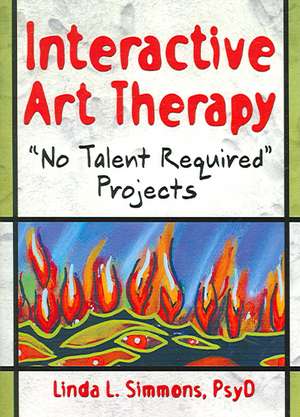Interactive Art Therapy: No Talent Required Projects
Autor Linda L. Simmonsen Limba Engleză Paperback – 16 iun 2006
Most people are visual learners. Seeing our ideas in pictures gives them greater impact and more meaning. Interactive Art Therapy: “No Talent Required” Projects presents a cutting-edge therapeutic technique founded on sound clinical principles, providing another practical tool any therapist or counselor can effectively use without anyone having to be a da Vinci. The book clearly discusses the clinical rationale behind using standard drawings in therapy and demonstrates how the interactive nature of the approach helps clients to quickly and easily gain deeper insight.
Interactive Art Therapy: “No Talent Required” Projects helps counselors and therapists empower the client to become an active participant in the therapeutic process, allowing the flexibility of the drawings to be adaptive to the client’s cognitive and developmental abilities. The book examines ways for practitioners to discern whether Interactive Art Therapy is a suitable clinical intervention for the client, then explores the ways each drawing can be used to help clients move toward breakthroughs in their therapy. The text uses case examples to clearly illustrate techniques and reveal the ways that clients’ drawings reflect their thought processes.
Interactive Art Therapy: “No Talent Required” Projects discusses how to use simple, client-friendly drawings such as:
- “Cage of Fears”
- “Teeter-Totter of Decision-Making”
- “The Coping Arch”
- “Boundary Castle”
- “Well of Needs”
- “Weight of the World”
- “Swamp of Sympathy”
- “Brick Wall of Barriers”
- “The Pressure Box”
- “Pole Vault for Goals”
| Toate formatele și edițiile | Preț | Express |
|---|---|---|
| Paperback (1) | 226.74 lei 6-8 săpt. | |
| Taylor & Francis – 16 iun 2006 | 226.74 lei 6-8 săpt. | |
| Hardback (1) | 1088.60 lei 6-8 săpt. | |
| Taylor & Francis – 19 iun 2006 | 1088.60 lei 6-8 săpt. |
Preț: 226.74 lei
Preț vechi: 272.44 lei
-17% Nou
Puncte Express: 340
Preț estimativ în valută:
43.42€ • 44.74$ • 36.43£
43.42€ • 44.74$ • 36.43£
Carte tipărită la comandă
Livrare economică 21 februarie-07 martie
Preluare comenzi: 021 569.72.76
Specificații
ISBN-13: 9780789026545
ISBN-10: 0789026546
Pagini: 180
Dimensiuni: 156 x 216 x 11 mm
Greutate: 0.33 kg
Ediția:1
Editura: Taylor & Francis
Colecția Routledge
Locul publicării:Oxford, United Kingdom
ISBN-10: 0789026546
Pagini: 180
Dimensiuni: 156 x 216 x 11 mm
Greutate: 0.33 kg
Ediția:1
Editura: Taylor & Francis
Colecția Routledge
Locul publicării:Oxford, United Kingdom
Cuprins
- Foreword (Lorna Hecker)
- Preface
- Acknowledgments
- Introduction
- Chapter 1. Theoretical Foundation for Interactive Art Therapy
- Dual-Coding Theory
- Contiguity Effect
- Applications for Interactive Art Therapy
- Chapter 2. Cage of Fears
- Objective
- Rationale
- Cage of Fears Exercise Instructions
- Vignette
- Suggestions for Follow-Up
- Contraindications for Use
- Chapter 3. Teeter-Totter of Decision Making
- Objective
- Rationale
- Teeter-Totter of Decision Making Exercise Instructions
- Vignette
- Suggestions for Follow-Up
- Contraindications for Use
- Chapter 4. The Coping Arch
- Objective
- Rationale
- The Coping Arch Exercise Instructions
- Vignette
- Suggestions for Follow-Up
- Contraindications for Use
- Chapter 5. Boundary Castle
- Objective
- Rationale
- Boundary Castle Exercise Instructions
- Vignette
- Suggestions for Follow-Up
- Contraindications for Use
- Chapter 6. Well of Needs
- Objective
- Rationale
- Well of Needs Exercise Instructions
- Vignette
- Suggestions for Follow-Up
- Contraindications for Use
- Chapter 7. Weight of the World
- Objective
- Rationale
- Weight of the World Exercise Instructions
- Vignette
- Suggestions for Follow-Up
- Contraindications for Use
- Chapter 8. Swamp of Sympathy
- Objective
- Rationale
- Swamp of Sympathy Exercise Instructions
- Vignette
- Suggestions for Follow-Up
- Contraindications for Use
- Chapter 9. Brick Wall of Barriers
- Objective
- Rationale
- Brick Wall of Barriers Exercise Instructions
- Vignette
- Suggestions for Follow-Up
- Contraindications for Use
- Chapter 10. Bloom Where You’re Planted
- Objective
- Rationale
- Bloom Where You’re Planted Exercise Instructions
- Vignette
- Suggestions for Follow-Up
- Contraindications for Use
- Chapter 11. The Pressure Box
- Objective
- Rationale
- The Pressure Box Exercise Instructions
- Vignette
- Suggestions for Follow-Up
- Contraindications for Use
- Chapter 12. Fisherman’s Wharf
- Objective
- Rationale
- Fisherman’s Wharf Exercise Instructions
- Vignette
- Suggestions for Follow-Up
- Contraindications for Use
- Chapter 13. Pole Vault for Goals
- Objective
- Rationale
- Pole Vault for Goals Exercise Instructions
- Vignette
- Suggestions for Follow-Up
- Contraindications for Use
- Chapter 14. The Spider Web
- Objective
- Rationale
- The Spider Web Exercise Instructions
- Vignette
- Suggestions for Follow-Up
- Contraindications for Use
- Chapter 15. The Cracked Vase
- Objective
- Rationale
- The Cracked Vase Exercise Instructions
- Vignette
- Suggestions for Follow-Up
- Contraindications for Use
- Epilogue
- References
- Index
Descriere
Most people are visual learners. Seeing our ideas in pictures gives them greater impact and more meaning. Interactive Art Therapy: “No Talent Required” Projects presents a cutting-edge therapeutic technique founded on sound clinical principles, providing another practical tool any therapist or counselor can effectively use without anyone having to be a da Vinci. The book clearly discusses the clinical rationale behind using standard drawings in therapy and demonstrates how the interactive nature of the approach helps clients to quickly and easily gain deeper insight. The text uses case examples to clearly illustrate techniques and reveal the ways that clients' drawings reflect their thought processes.
























